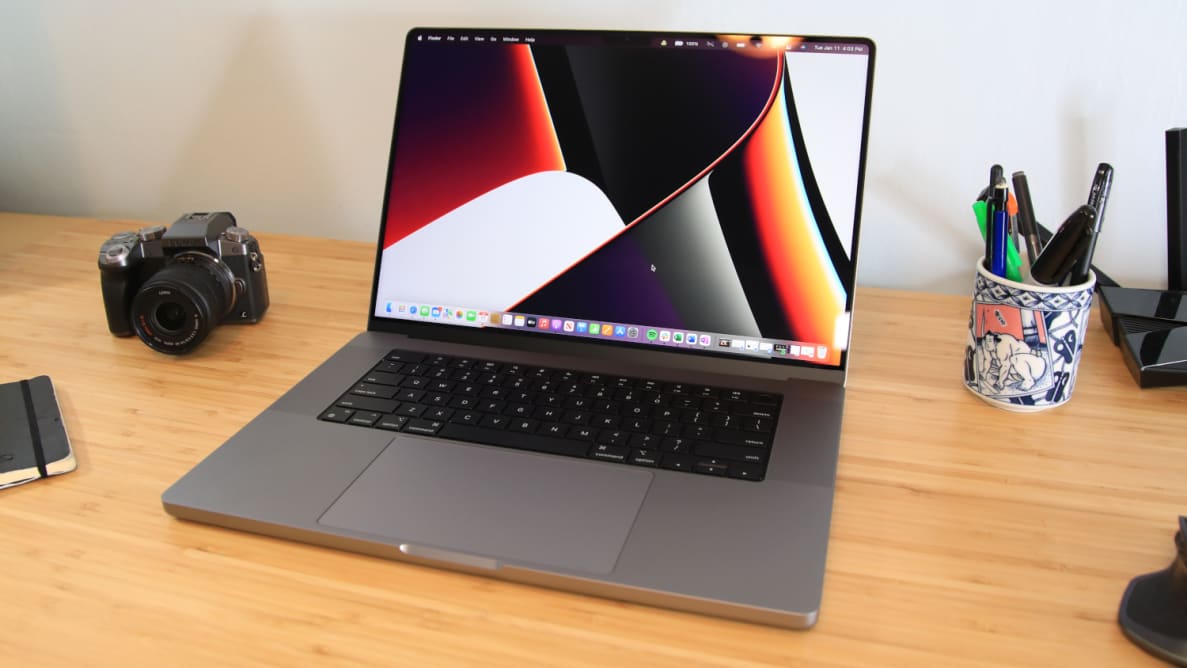Pros
-
Exceptional battery life
-
Blazing fast in most apps
-
Class-leading display
Cons
-
Lack of Face ID is a bummer
-
Some apps aren’t optimized
Review body
About the MacBook Pro 16 M1 Max
- Processor: M1 Max 10-Core CPU
- Graphics: M1 Max 32-Core GPU
- RAM: 32GB
- Storage: 1TB Unified Memory
- Display: 3456 x 2234 Liquid Retina XDR
- Wireless connectivity: Wi-Fi 6, Bluetooth 5
- Wired connectivity: 3x USB Type-C 4 / Thunderbolt 4, 1x HDMI, 1x Headphone, 1x SDcard reader, MagSafe power connector
- Webcam: 1080p
- Battery: 100 watt-hour battery
- Weight: 4.8 pounds
- Size: 14.01 x 9.77 x 0.66 inches
Apple offers three basic MacBook Pro 16 configurations. The range starts with the $2,499 base model that has an M1 Pro chip, 16GB of RAM, and 512GB of unified memory. Our tester was a high-end, $3,499 configuration with the M1 Max, 32GB of RAM, and 1TB of memory. Serious power users can boost RAM up to 64GB and unified memory up to 8TB for a maximum all-in price of $6,099.
It’s expensive, but Apple has packed a lot of performance, and battery life, into every inch of its MacBook Pro 16.
What we like
Revolutionary battery life
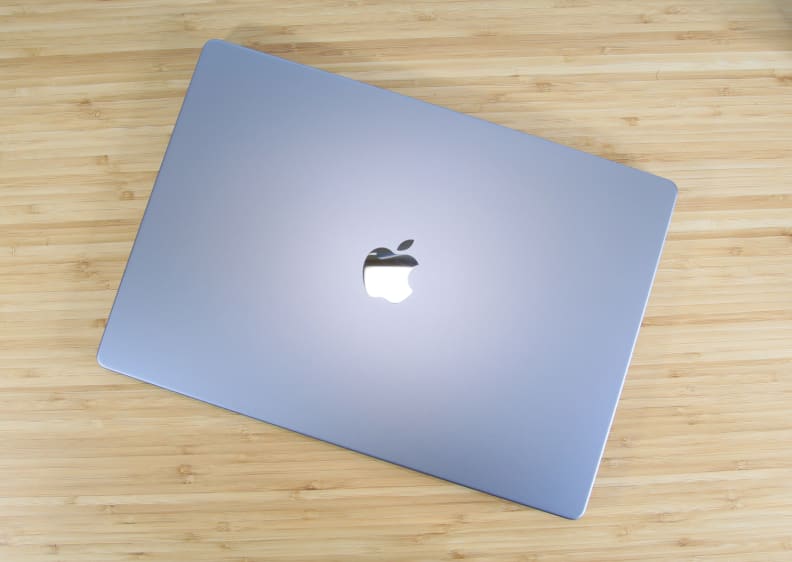
The MacBook Pro 16's battery can last up to 22.5 hours!
There’s a lot to love about the MacBook Pro 16, but one feature leaps beyond excellence and is truly revolutionary: The battery life.
The Pro 16's battery lasted for 22 hours and 32 minutes during our standard battery test, which uses a macro to simulate web browsing in Google Chrome. To date, that's the longest a laptop battery has ever lasted in all our testing.
By comparison, Dell’s XPS 17 (one of the best large Windows laptops available) achieved just six hours and 43 minutes in the same test. Even Windows laptops built for portability, like the Dell XPS 13 or the 13-inch Microsoft Surface Pro X, last less than ten hours.
Battery life held up in real-world use. At times, the battery drained just a few percent after an hour of web browsing. Using the laptop for a workday of document editing and online research placed the battery below 75%.
For many, the Pro 16 will last two or three days before it needs to be topped off. Those with a habit of charging it nightly may never see it dip to a critical level. Owners with demanding needs (like video editing or gaming) will want to charge it more frequently. However, unlike Windows alternatives, the Pro 16 has truly useful endurance in the most demanding apps.
The only downside is the Pro 16’s size. This is a large, heavy laptop, measuring 14 inches wide and weighing almost five pounds. Apple’s 13-inch and 14-inch Pro models are more portable, but have smaller batteries, pushing battery life into the low teens (depending on model).
But this feels like a nitpick. Apple’s MacBook Pro 16 demolishes similar Windows competition, lasting three to four times longer on a charge. It’s a huge win for the Mac.
Apple's M1 Max chip proves its worth
The MacBook Pro 16’s battery life would be exceptional even for its least powerful iteration, but that’s not the model we tested. Our Pro 16 packed the full-fat Apple M1 Max chip with 10 CPU cores and 32 GPU cores. It was paired with 32GB of memory and a 1TB hard drive.
Performance? Yeah, it has that.
The Geekbench 5 benchmark, which tests raw processing power, spat out a single-core score of 1777 and multi-core score of 12791—exceptional numbers, the best we have seen to date from a laptop processor. The Dell XPS 17 we tested with Intel Core i7-11800H processor achieved a single-core score of 1564 and a multi-core score of 7999, by comparison, and MSI’s GE76 Raider with Intel’s Core i9-11980H hit 1636 and 9118, respectively. Apple’s M1 Max has a clear advantage in this test.
M1 Max did well in other CPU benchmarks including Cinebench, Basemark, and Speedometer. The MSI GE76 Raider was able to take the lead in Basemark and Speedometer tests, but the Dell XPS 17 (and other Windows laptops) remained behind.
The Pro 16 was excellent in real-world application tests. The CPU rendered Blender’s BMW car test scene in three minutes and 32 seconds, a task which took the Dell XPS 17 four minutes and five seconds. With that said, a few Windows laptops can beat the Pro 16 in this test. Asus’ ROG Strix G15 AMD Advantage Edition, for example, rendered the scene in three minutes and 19 seconds.
Processor performance is only half the story; M1 Max also has 32 GPU cores, double the 16 cores in Apple’s base MacBook Pro 16. This is the highest GPU core count of any Apple M1 chip.
The M1 Max delivered an average of 115 frames per second (fps) in Total War: Warhammer II at 1080p resolution and Ultra detail. Shadow of the Tomb Raider averaged 85 fps at 1080p and Highest detail. Dell’s XPS 17, which we tested with Nvidia’s RTX 3060, is far behind in both. It averaged 80 fps in Total War and 59 fps in Tomb Raider.
However, other Windows laptops can compete with or beat the Pro 16’s game performance. The MSI GE76 Raider, packing Nvidia’s RTX 3080, averaged 100 fps in Warhammer and 119 fps in Tomb Raider. Asus’ ROG Strix G15 with AMD’s Radeon RX 6800M averaged 75 and 105 fps, respectively.
It’s not all good news for the Mac, however. Civilization VI averaged just 43 fps at 1080p and Ultra detail and turning the graphics detail down to High hardly improved the frame rate. This suggests 3D performance could be lackluster in applications not yet optimized for Apple’s M1 Max.
Still, the M1 Max is fantastic overall. Its CPU and GPU performance is exceptional for the Pro 16’s weight and size. Windows laptops that outperform it are typically larger, heavier beasts. Dell’s XPS 17, the Pro 16’s most direct Windows competitor, can’t keep up.
Apple’s mini-LED display gives OLED serious competition
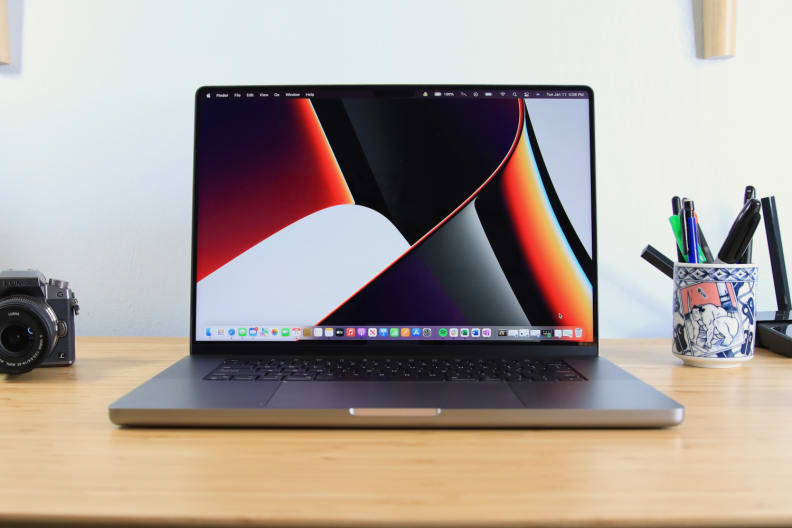
Nearly everything about Apple's MacBook Pro 16 M1 Max blew us away.
Many high-end Windows laptops have an OLED display, but Apple goes a different route for the MacBook Pro 16 (and MacBook Pro 14). It relies on mini-LED, which uses thousands of individual LEDs to light the display. These are grouped into 2,554 zones which can brighten or dim independently. Apple calls it Liquid Retina XDR.
This offers less precision than OLED, where every pixel’s luminance is independent, but it’s close enough to provide similar benefits. The result is a rich, deep image with convincing shadows and outstanding detail.
It’s sharp, as well, with 3456 x 2234 resolution. That translates to 254 pixels per inch, an upgrade from prior MacBook Pro models, which packed around 220 pixels per inch. Windows’ competitors tend to have an edge, though, as many have a 4K OLED option.
The Liquid Retina XDR display’s best trait is its HDR performance. Brightness is high in normal use and, according to Apple, can exceed 1600 nits in HDR highlights that drive high brightness to a small portion of the display, such as a sunrise or a field of stars.
My eyes say Apple’s Liquid Retina XDR has an advantage over OLED and edge-lit LED displays. A great HDR movie, like Avengers: Endgame, can look stunning. The same is true of games that support HDR. No Windows laptop sold today look just as bright, punchy, or vivid.
There is a compromise: blooming. The dimming zones on the Pro 16 are small, but not pixel-perfect, so you may see halos of light around small, bright objects as they move on a dark scene. I thought it was only noticeable in a dark room, but it’s there.
The Liquid Retina XDR display also has an enhanced 120Hz refresh rate for smooth animation and motion. The difference is subtle but noticeable when using multi-touch gestures or keyboard hotkeys to flip through open windows and apps. Windows laptops also offer high refresh rates but tend not to feel as smooth in practice, and most with OLED have a 60Hz refresh rate.
Solid improvements to the classic MacBook design
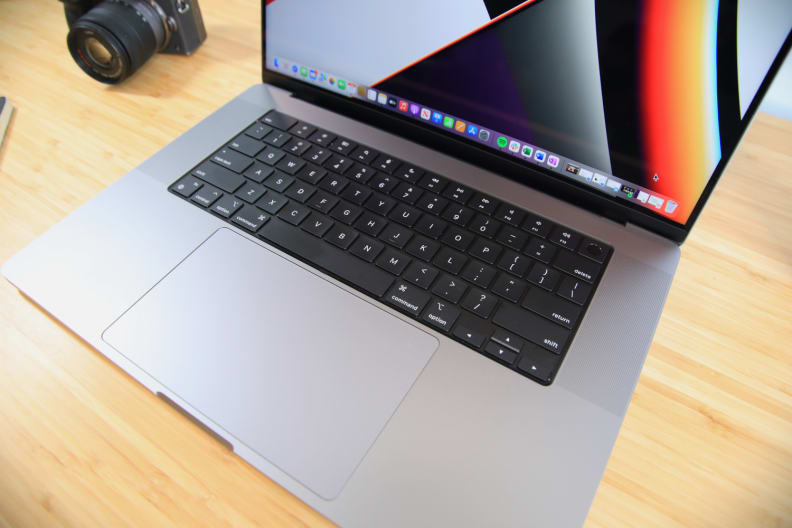
The MacBook Pro 16 has one of the best laptop keyboards.
The new MacBook Pro 16 looks a lot like its predecessor at first glance. It still has a recycled aluminum unibody chassis, it’s still sold in silver or space gray, and it retains a familiar rectangular shape with rounded edges and flat flanks.
Pick it up, though, and the new Pro 16 feels even more refined than before. The display hinge is tuned to perfection, allowing easy and smooth operation with one hand. The display lid is thinner yet just as sturdy, and smaller display bezels help the new Pro 16 achieve a more compact footprint.
The keyboard is great. Apple has returned to a scissor-switch key design, the most common among laptops, after experimenting with a design called the butterfly switch for several years. Key-feel is modest, but sufficient, and ends with a firm, tactile sensation.
Apple has traded its intriguing but controversial Touch Bar for a row of physical function keys—the right call since the physical buttons are more intuitive. Touch ID, Apple’s fingerprint-based biometric security, remains standard and is still placed on the function row’s right side.
While much has changed, the massive Force Touch touchpad hasn’t. It remains the largest available on any laptop sold today and offers a smooth, responsive surface. The lack of physical buttons isn’t such a huge deal since the touchpad has haptic feedback, which convincingly simulates a physical click.
Apple includes all the essential ports in its new MacBook Pro 16: three USB-C 4 / Thunderbolt 4 ports, a headphone jack, an SD card reader, and a full-sized HDMI port. MagSafe charging is back, as well, offering a simple and secure way to top up the battery. The USB-C 4 / Thunderbolt 4 ports can charge the laptop.
What we don’t like
No FaceID
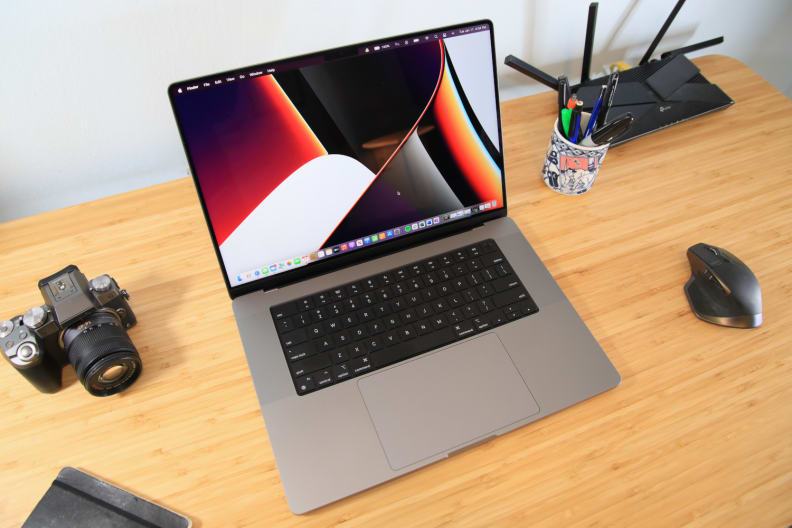
Apple did away with the Touch Bar on its new MacBook Pro 16.
Mac fans were surprised and shocked to see the new MacBook Pro 14 and 16 add a display notch to house the webcam. Fortunately, it’s not as distracting as on Apple’s iPhone. The notch is larger but consumes a far smaller portion of the display, and its position (the middle of the top bezel) is rarely used by apps.
Yet there is a problem: The Mac still doesn’t support Face ID.
That’s a bummer. Face ID is an ideal way to log in to any tablet, smartphone, or laptop. In fact, we’d argue it’s better suited for a laptop than any other device. Your face is less likely to be obscured or tilted at an odd angle compared to positioning your iPhone’s camera in front of your face.
Windows pours salt in Apple’s wound with Windows Hello, a feature similar to Face ID that’s now widely available on high-end Windows laptops—and works extremely well.
Some PC makers, like Lenovo, take the tech a step further with a feature it calls “human presence detection” that can automatically lock compatible laptops when you step away from the machine, then unlock when you return.
This won’t be a deal-breaker for most people but, given the Pro 16’s price, it’s odd this premium feature is missing.
Where’s the low-end model?
The $3,499 MacBook Pro 16 we tested had 10 CPU cores and 32 GPU cores with 32GB of memory and 1TB of storage. Comparatively, the Dell XPS 17 9710, which we tested with identical memory and storage, sells for around $2,799. That’s a $700 gap in favor of the Dell.
Apple’s base price is high, too. Dell’s XPS 17 starts at $1,449.99, over $1,000 less than the entry-level Pro 16. This entry-level XPS 17 has a modest Core i5 processor and just 8GB of memory, but it’s nice to have a less expensive choice if you care more about a big screen than a beefy processor. The price of Apple’s Pro 16 can look even less appealing compared to less expensive Windows options, such as HP’s ZBook Fury 17 and Lenovo’s ThinkPad X1 Extreme Gen 4. These laptops start at or just below $2,000 (depending on sales).
This is not to say the MacBook Pro 16 is a bad value—its performance and battery life can justify the expense. Still, it’d be nice to see a wider range of configuration options, such as an entry-level model with a standard M1 chip. The Pro 16’s big screen and battery life would be useful for Mac fans who don’t need top-tier performance.
Should you buy it?
Yes, the MacBook Pro 16 is arguably the best MacBook yet
The MacBook Pro 16 is a star in all the ways that matter. It’s a leader in battery life, display quality, and performance for its size. The keyboard is great, the touchpad is top-notch, and its design is gorgeous. It’s in every way an upgrade from the 2019 MacBook Pro 16 it replaced.
Additionally, Apple’s transition from Intel to its own custom chips unlocked a new world of apps ported from iOS. However, most apps designed for Intel-powered Macs still work. macOS pairs well with cloud services like iMessage, Photos, iCloud Drive, and Apple Arcade, making it ideal if you already own an iPhone. The Windows alternatives, such as Dell’s XPS 17 and Lenovo’s ThinkPad X1 Extreme, are often more affordable and offer entry-level models for those on a modest budget. Still, the MacBook Pro 16 remains a good value overall. Its performance and battery life beat the competition.
That won't help if you can’t afford it, of course. If you can, though, don’t let the price turn you off. The MacBook Pro 16 is worth it.
Meet the tester
Matthew S. Smith is a veteran tech journalist and general-purpose PC hardware nerd. Formerly the Lead Editor of Reviews at Digital Trends, he has over a decade of experience covering PC hardware. Matt often flies the virtual skies in Microsoft Flight Simulator and is on a quest to grow the perfect heirloom tomato.
Checking our work.
Our team is here to help you buy the best stuff and love what you own. Our writers, editors, and experts obsess over the products we cover to make sure you're confident and satisfied. Have a different opinion about something we recommend? Email us and we'll compare notes.
Shoot us an email
